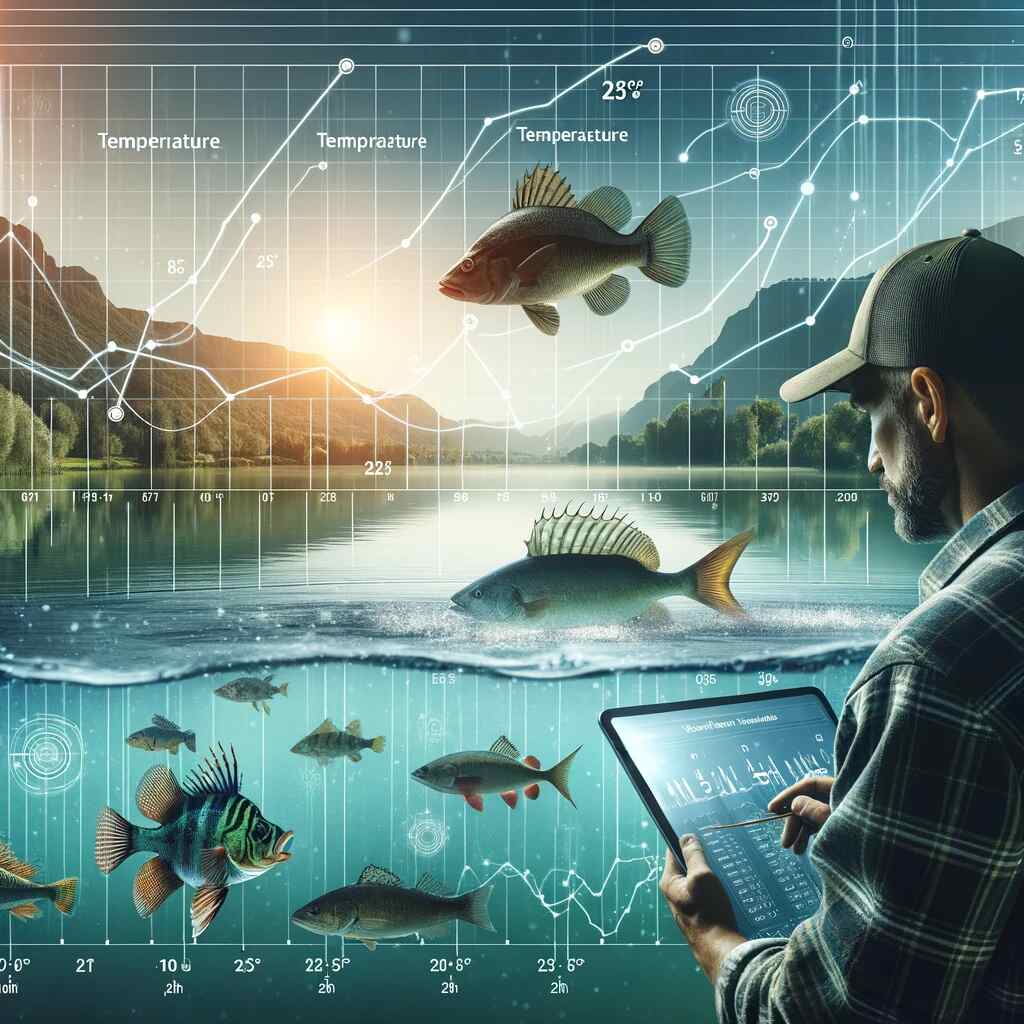Water temperature is a critical environmental factor that significantly influences fish behavior. Whether you’re an angler looking to improve your catch rate or a fisheries biologist studying fish populations, understanding how to interpret water temperature data is essential.
In this comprehensive guide, we will delve into the science behind fish behavior in relation to water temperature and provide practical tips for interpreting this data to predict fish activity and optimize your fishing strategies.
The Importance of Water Temperature
Fish are ectothermic, which means their body temperature is regulated by the surrounding water. Water temperature affects nearly every aspect of a fish’s life, from its metabolic rate to its feeding habits and reproduction. Here are some key reasons why water temperature is crucial for predicting fish behavior:
- Metabolic Rate: Water temperature directly impacts a fish’s metabolic rate. As the temperature rises, so does the fish’s metabolic activity. This means they require more energy, leading to increased feeding activity.
- Feeding Patterns: Fish have specific temperature preferences for feeding. Some species are more active in warmer waters, while others prefer cooler conditions. Understanding these preferences is essential for successful fishing.
- Reproduction: Many fish species have specific temperature requirements for spawning. Knowing the optimal temperature range for spawning can help fisheries managers protect and enhance fish populations.
- Habitat Selection: Water temperature influences fish distribution and habitat selection. Fish will migrate or seek specific areas within a water body to find their preferred temperature range.
- Seasonal Changes: Fish behavior varies seasonally due to temperature fluctuations. Understanding these patterns can improve your chances of a successful catch.
Collecting Water Temperature Data
Before we dive into interpreting water temperature data, it’s essential to know how to collect accurate temperature measurements. Here are some methods commonly used to gather water temperature data:
- Thermometers: Traditional mercury or digital thermometers are suitable for measuring water temperature near the surface. Simply immerse the thermometer in the water and wait for it to stabilize.
- Temperature Loggers: These devices record water temperature over time. They are often placed at different depths in the water column to monitor temperature variations throughout the day and night.
- Fish Finders with Temperature Sensors: Some fish finders come equipped with temperature sensors that can provide real-time water temperature data. These are useful for anglers to identify temperature variations in different areas of the water body.
- Satellite Data: Remote sensing satellites can provide valuable information on sea surface temperatures, which is particularly useful for studying large bodies of water like oceans.
Once you have collected water temperature data using one or more of these methods, you can begin the process of interpreting it to predict fish behavior effectively.
Understanding Temperature Preferences of Fish Species
Different fish species have specific temperature preferences and tolerances. To interpret water temperature data accurately, it’s crucial to know the temperature ranges that different fish species prefer. Here are some general temperature preferences for common sportfish:
- Warmwater Species (e.g., Bass, Bluegill): These fish thrive in water temperatures ranging from 70°F to 85°F (21°C to 29°C). They are most active and feed aggressively in warm water conditions.
- Coolwater Species (e.g., Walleye, Pike): Coolwater fish prefer temperatures between 50°F and 70°F (10°C to 21°C). They are most active during the spring and fall when water temperatures are in this range.
- Coldwater Species (e.g., Trout, Salmon): Coldwater fish are most comfortable in temperatures ranging from 45°F to 65°F (7°C to 18°C). They are typically found in clear, cold streams and lakes.
- Tropical Species (e.g., Tarpon, Snook): These fish thrive in water temperatures exceeding 70°F (21°C) and are often found in tropical and subtropical regions.
- Anadromous Fish (e.g., Salmon): These species migrate between freshwater and saltwater habitats and often have specific temperature requirements for spawning and feeding.
Keep in mind that individual fish within a species may exhibit variations in temperature preferences. Additionally, local factors such as habitat conditions and seasonal changes can influence fish behavior.
Interpreting Water Temperature Data
Now that you understand the importance of water temperature and the preferences of different fish species, let’s explore how to interpret water temperature data effectively:
1. Monitor Temperature Trends
One of the first things you should do when analyzing water temperature data is to look for trends. Pay attention to the following:
- Daily Temperature Fluctuations: Water temperature typically follows a daily cycle, with the warmest temperatures occurring in the late afternoon and the coolest temperatures in the early morning. Fish often adjust their behavior in response to these fluctuations.
- Seasonal Trends: Observe how water temperature changes throughout the year. Identify the temperature range associated with each season in your region. Fish are likely to be more active and behave differently during different seasons.
- Frontal Passages and Weather Patterns: Sudden changes in temperature may occur with the passage of cold fronts or warm fronts. These weather events can have a significant impact on fish behavior. Be prepared to adapt your fishing strategies accordingly.
2. Consider Depth and Thermal Layers
Water temperature can vary significantly with depth in a water body. As you collect temperature data at various depths, pay attention to the presence of thermal layers. These layers are distinct zones with temperature differences, and fish often concentrate in specific layers. The three primary thermal layers are:
- Epilimnion: The uppermost layer with the warmest water, where sunlight penetrates and supports photosynthesis. Many fish species are found in this layer during the warmer months.
- Metalimnion (Thermocline): A transition layer where temperature rapidly decreases with depth. Fish may use the thermocline as a refuge during extreme temperatures.
- Hypolimnion: The coldest and deepest layer in a stratified lake. Some fish species, especially in deep, clear lakes, inhabit this layer year-round.
Understanding the depth of thermal layers and the temperature gradients within a water body can help you target specific fish species more effectively.
3. Analyze Temperature Variability
Temperature variability can provide valuable insights into fish behavior. Look for patterns in temperature fluctuations and how fish respond to them. Consider the following factors:
- Rate of Temperature Change: Sudden temperature changes can trigger feeding activity in some fish. For example, a rapid warming trend after a cold snap might lead to increased fish activity.
- Temperature Stability: Some fish prefer stable temperature conditions, while others are more adaptable. Analyze whether fish are more active during stable periods or when temperature changes are occurring.
- Localized Temperature Differences: In larger bodies of water, temperature can vary between different areas. Use temperature data to identify areas with optimal conditions for your target species.
4. Combine Data Sources
To get a comprehensive picture of water temperature conditions, consider combining data from various sources. For example:
- Surface Temperature: Measure surface temperature with a thermometer or fish finder to understand the immediate conditions that affect fish behavior.
- Thermal Profiles: Deploy temperature loggers at different depths to create thermal profiles of the water body. This will help you identify thermal layers and the distribution of fish.
- Historical Data: Compare current temperature data with historical records to identify trends and anomalies.
- Weather Data: Incorporate weather forecasts and historical weather data to anticipate temperature changes driven by weather patterns.
5. Experiment and Record Observations
Interpreting water temperature data is not always straightforward, as fish behavior can vary depending on numerous factors. To enhance your understanding, conduct experiments and keep a detailed fishing journal. Note the following:
- Bait Presentation: Experiment with different bait types and presentations at varying water temperatures. Record which combinations are most effective.
- Catch Records: Keep records of your fishing trips, noting water temperature, weather conditions, and the species you catch. Over time, you may identify patterns and correlations.
- Observations: Pay attention to fish behavior when you’re on the water. Note any changes in activity levels, feeding behavior, and movement in response to temperature fluctuations.
Practical Tips for Predicting Fish Behavior
Now that you have a solid foundation in interpreting water temperature data, here are some practical tips to help you predict fish behavior and improve your fishing success:
1. Timing Matters
Timing your fishing trips based on water temperature can greatly increase your chances of success. As a general guideline:
- Spring: Many fish species become more active as water temperatures rise during the spring months. Monitor the temperature closely and plan your outings when it’s within the preferred range for your target species.
- Summer: In warmwater fisheries, early morning and late afternoon are prime times for fishing. Fish are often more active during these cooler periods. However, in extremely hot weather, they may become less active during the day.
- Fall: Fall is a transition period when water temperatures start to drop. Fishing can be excellent as fish feed heavily to prepare for winter. Monitor temperature trends and target species that are active in cooler waters.
- Winter: In colder climates, ice fishing becomes popular. Fish are more sluggish in cold water, so use bait and lures that move slowly. Monitor temperature changes to identify optimal fishing times.
2. Adapt Your Bait and Lure Selection
Water temperature should influence your choice of bait and lures. Consider the following:
- Live Bait: Fish are often more receptive to live bait when the water is colder. Minnows, worms, and insects can be highly effective in cooler conditions.
- Lure Action: Match the action of your lures to the fish’s activity level. In colder water, opt for slow-moving lures, while in warmer water, use lures with more action to entice strikes.
- Color Selection: Fish may respond differently to lure colors based on water clarity and temperature. Experiment with different colors to see which ones are most effective.
3. Focus on Key Locations
Understanding how water temperature varies within a water body allows you to pinpoint key locations where fish are likely to congregate. Look for areas that offer:
- Thermal Layers: Target specific thermal layers where your target species are most active. This may require using downriggers or other equipment to reach the desired depth.
- Structure: Fish often seek shelter and ambush points near underwater structures like rocks, logs, and vegetation. These areas can offer more stable temperature conditions.
- Currents and Oxygen Levels: Temperature gradients can influence water circulation and oxygen levels. Fish may gather in areas with ideal temperature and oxygen conditions.
4. Stay Informed About Local Conditions
Stay updated on local fishing reports, which often include information about water temperature and fish activity. Additionally, consider joining fishing forums or social media groups where anglers share real-time information and insights about local fishing conditions.
5. Be Patient and Flexible
Fish behavior can be unpredictable, even with the best water temperature data and strategies. Be patient and be willing to adapt your approach if you’re not getting the desired results. Sometimes, a slight change in bait, presentation, or location can make all the difference.
Conclusion
Interpreting water temperature data is a valuable skill for anglers and fisheries professionals alike. By understanding the relationship between water temperature and fish behavior, monitoring temperature trends, and adapting your strategies accordingly, you can significantly improve your chances of a successful fishing trip.
Remember that fish behavior is influenced by a combination of factors, and water temperature is just one piece of the puzzle. Continuously gather data, experiment, and learn from your observations to become a more effective and knowledgeable angler.









